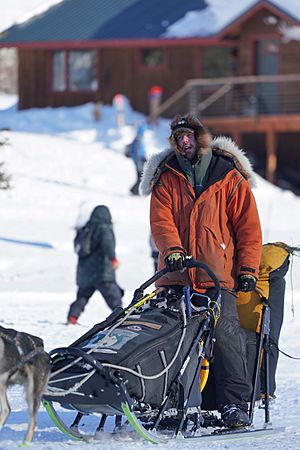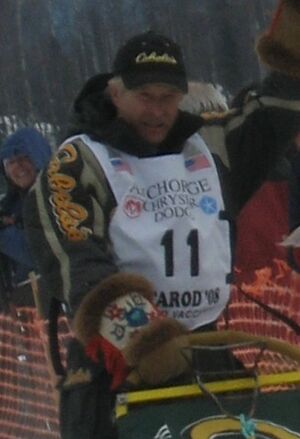Iditarod facts for kids
Quick facts for kids Iditarod |
|
|---|---|
| Date | March |
| Location | Anchorage to Nome, Alaska, United States |
| Event type | Sled Dog Race |
| Distance | 938 mi (1,510 km) |
| Established | 1973 |
| Course records | Dallas Seavey, 7 d 14h 8m 57s (2021) |

The Iditarod Trail Sled Dog Race, often called The Iditarod, is a famous long-distance sled dog race. It happens every year in Alaska in early March. The race goes from Anchorage to Nome.
Teams of mushers and 12 to 16 dogs race across the snowy land. They cover the distance in about 8 to 15 days. The Iditarod started in 1973. It was created to test the best sled dog teams. Now, it's a very tough competition.
Racers often face blizzards with whiteout conditions. Temperatures can drop below zero. Strong winds can make it feel as cold as −100 °F (−73 °C).
The race has a fun start in Anchorage. The official race begins in Willow, about 80 miles (129 km) north of Anchorage. The trail goes through the Alaska Range mountains. It then follows the Bering Sea coast to Nome. The path crosses tundra, forests, hills, and rivers. It even goes over sea ice! Most of the route is through small towns and Native Alaskan villages. The Iditarod connects people to Alaska's early history. It celebrates the tradition of dog mushing.
The Iditarod is a very popular sport in Alaska. Top mushers and their dogs are local heroes. This race helped bring back recreational mushing in Alaska. Most mushers are from Alaska. But people from 14 other countries have also finished the race. Martin Buser from Switzerland was the first foreign winner in 1992. Fans around the world follow the race online. Many volunteers come to Alaska to help at checkpoints.
The race became more famous after 1985. That year, Libby Riddles became the first woman to win. She was a surprise winner. The next year, Susan Butcher won. She went on to win three more times. Many reporters and fans come to watch the start in Anchorage. They also visit checkpoints along the trail.
Mitch Seavey set the fastest time in 2017. He finished in 8 days, 3 hours, 40 minutes, and 13 seconds. He also became the oldest winner.
Contents
What's in a Name?
The race is named after the Iditarod Trail. This trail became a US National Historic Trail in 1978. The trail itself is named after the town of Iditarod. This town was once a Native Athabaskan village. It became a busy mining town in 1910. After the gold rush ended, it became a ghost town. The town was named after the Iditarod River. The river's name comes from an Athabascan word, Haidilatna.
A Look Back: Race History
Parts of the Iditarod Trail were used by Native Alaskan peoples for hundreds of years. This was long before Russian traders arrived in the 1800s. The trail was most used between the late 1880s and the 1920s. Miners used it to find coal and gold. This was especially true after the gold rushes in Nome (1898) and the "Inland Empire" (1908).
During summer, steamships were the main way to travel. But from October to June, northern ports like Nome froze. So, dog sleds carried mail, firewood, and supplies. They moved goods between trading posts and towns. Roadhouses, where travelers could rest, appeared every 14 to 30 miles (23 to 48 km). By the late 1920s, bush pilots and small planes took over. Dog sledding became less common. It almost disappeared in the 1960s with snowmobiles.
Dog mushing was also a popular sport in winter. The first big race was the 1908 All-Alaska Sweepstakes. This race was 408 miles (657 km) long. It introduced Siberian Huskies to Alaska. These dogs quickly became favorites for racing.
Joe Redington Sr. had the idea to race on the Iditarod trail. He is called the "Father of the Iditarod." He worked with Gleo Huyck and Tom Johnson to create the race. They planned to race from Knik to Iditarod and back. Their friend, Bill Weimar, suggested starting in Anchorage. This was because Anchorage had more people. They cleared part of the trail. They also raised $51,000 for prizes. The first Iditarod Race was in 1973. Thirty-four mushers competed, and 22 finished.
The race was a big success. Even though prize money dropped in 1974, more mushers joined. In 1975, companies started sponsoring the race. This made the race financially stable. The Iditarod helped bring back dog mushing in the 1970s. It is now the biggest sporting event in Alaska.
The main Iditarod trail is 938 miles (1,510 km) long. It goes from Seward in the south to Nome in the northwest. The modern race uses parts of this historic trail.
The Race Route
The Iditarod uses two main routes. The northern route is used in even-numbered years (like 2024). The southern route is used in odd-numbered years (like 2023). Both routes follow the same trail for 352 miles (566 km). They start in Anchorage and go to Ophir. Then they split up and meet again at Kaltag. Kaltag is 346 miles (557 km) from Nome.
The southern route was added in the late 1970s. This helped spread out the race's impact on small villages. It also allowed the race to pass through the historic town of Iditarod. The two routes are only about 25 miles (40 km) different in length. The northern route is officially 975 miles (1,569 km) long. The southern route is 998 miles (1,606 km) long. People often round the distance to 1,000 mi (1,609.34 km).
Sometimes, the route changes due to weather. In 2015 and 2017, there wasn't enough snow. The race had to start in Fairbanks, Alaska. In 2021, because of the COVID-19 pandemic, the race used a special 832-mile loop. It started and ended in Willow.
Checkpoints Along the Trail
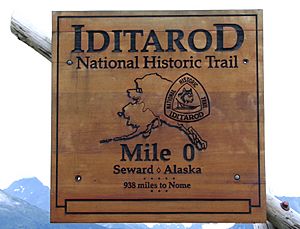
There are 26 checkpoints on the northern route and 27 on the southern route. Mushers must sign in at each one. Some mushers rest at checkpoints, while others keep going. Mushers send "drop bags" of supplies ahead to each checkpoint. These bags have food for dogs and mushers, dog booties, headlamps, and repair tools.
Teams must take three mandatory rests during the race. One is a 24-hour rest at any checkpoint. Another is an eight-hour rest on the Yukon River. The last is an eight-hour stop at White Mountain.
In 1985, the race was stopped for safety. Bad weather kept planes from delivering supplies to checkpoints. Fifty-eight mushers and 508 dogs waited at Rainy Pass for three days.
The Ceremonial Start
| Ceremonial start |
|---|
| Anchorage to Campbell Airstrip 11 miles (18 km) |
| Highway |
| Campbell Airstrip to Willow 29 miles (47 km) |
| Restart |
The race starts on the first Saturday in March. It begins on Fourth Avenue in downtown Anchorage. Snow is brought in by truck to cover the street.
Before the race, a ribbon-cutting ceremony takes place. An honorary musher, chosen for their work in dog sledding, starts first. The first competitor leaves at 10:02 a.m. AST. Other teams follow every two minutes. The starting order is chosen by drawing numbers.
This part of the race is exciting for dogs and mushers. It's one of the few times they see many spectators. The time for this section doesn't count towards the official race time. So, teams can take it easy. Mushers then travel through city streets and trails. They reach the foothills of the Chugach Mountains. Teams then drive about 30 miles (48 km) to the official restart point.
The Official Restart
| Restart |
|---|
| Willow to Yentna Station 42 mi (68 km) |
| Yentna Station to Skwentna 30 mi (48 km) |
| Skwentna to Finger Lake 40 mi (64 km) |
| Finger Lake to Rainy Pass 30 mi (48 km) |
| Into the Interior |
The race officially restarts the next day (Sunday) at 2:00 p.m. AST. This later start means dogs begin in colder weather. The first 100 miles (160 km) from Willow is called "moose alley." Many moose live here. They sometimes use the trails, which can be dangerous for dog teams.
The trail to Skwentna is usually easy and flat. Most mushers travel through the night. Skwentna is a popular spot for journalists and fans.
From Skwentna, the trail gets harder. It goes into the Alaska Range mountains to Finger Lake. The path from Finger Lake to Rainy Pass is very tough. It follows the narrow Happy River Gorge. Here, the trail is on the side of a steep hill. Rainy Pass is known as the most dangerous checkpoint. Mushers have broken bones here.
Journey into the Interior
| Into the Interior |
|---|
| Rainy Pass to Rohn 48 mi (77 km) |
| Rohn to Nikolai 75 mi (121 km) |
| Nikolai to McGrath 48 mi (77 km) |
| McGrath to Takotna 18 mi (29 km) |
| Takotna to Ophir 25 mi (40 km) |
| Trails diverge |
From Rainy Pass, the trail climbs over the Alaska Range. Then it drops into the Alaska Interior. The pass is 3,200 feet (975.4 m) high. Blizzards can hit this area. Temperatures can drop to −50 °F (−46 °C). Winds of 50-mile-per-hour (80.5 km/h) can make it feel like −130 °F (−90 °C). The wind also makes the trail hard to see.
The trail down Dalzell Gorge is considered the worst part. It drops 1,000 feet (300 m) in just 5 miles (8.0 km). Mushers have to use their brakes a lot. The Tatina River can also be dangerous. Ice can be thin in places.
Rohn is the next checkpoint. It's a popular place for mushers to rest. From Rohn, the trail follows the Kuskokwim River. Freezing water running over ice, called "overflow," is a danger. Mushers can get frostbite.
About 45 miles (72 km) from Rohn is the Farewell Burn. This area was burned by a wildfire in 1976. The burnt trees and uneven ground make it hard to travel. It can also hurt the dogs' paws.
Nikolai is the first Native American village used as a checkpoint. The race is a big event for the village. The trail then goes to McGrath, a former mining town. McGrath is the largest checkpoint in the Interior. It has a good airfield, so many journalists visit.
After McGrath are Takotna and Ophir. By this point, the fastest mushers are often days ahead of the slower ones.
Northern or Southern Route Choice
| Northern route (even years) |
|---|
| Ophir to Cripple 73 mi (117 km) |
| Cripple to Ruby 70 mi (110 km) |
| Ruby to Galena 50 mi (80 km) |
| Galena to Nulato 37 mi (60 km) |
| Nulato to Kaltag 47 mi (76 km) |
| Trails rejoin |
| Southern route (odd years) |
|---|
| Ophir to Iditarod 80 mi (130 km) |
| Iditarod to Shageluk 55 mi (89 km) |
| Shageluk to Anvik 25 mi (40 km) |
| Anvik to Grayling 18 mi (29 km) |
| Grayling to Eagle Island 62 mi (100 km) |
| Eagle Island to Kaltag 60 mi (97 km) |
| Trails rejoin |
After Ophir, the trail splits into two routes. They meet again at Kaltag. The northern route is used in even-numbered years. It passes through Cripple and Ruby. Ruby is on the Yukon River.
The southern route is used in odd-numbered years. It goes through the ghost town of Iditarod. Then it passes through the villages of Shageluk, Anvik, and Grayling. It continues to Eagle Island.
Both Ruby and Anvik are on the Yukon River, Alaska's longest river. Strong winds can make the trail disappear. The cold can feel like −100 °F (−73 °C). This long, uniform stretch can cause mushers to feel very tired. Many report seeing things that aren't there because of sleep deprivation.
Both trails join again in Kaltag. This town has been a link between Native Athabaskan and Iñupiat villages for hundreds of years. The "Kaltag Portage" leads to Unalakleet on the Bering Sea coast.
The Final Push to Nome
| Trails rejoin |
|---|
| Kaltag to Unalakleet 85 mi (137 km) |
| Last dash |
| Unalakleet to Shaktoolik 40 mi (64 km) |
| Shaktoolik to Koyuk 50 mi (80 km) |
| Koyuk to Elim 48 mi (77 km) |
| Elim to Golovin 28 mi (45 km) |
| Golovin to White Mountain 18 mi (29 km) |
| White Mountain to Safety 55 mi (89 km) |
| Safety to Nome 22 mi (35 km) |
| End of Iditarod |
| Southern route: 998 miles (1,606 km) |
| Northern route: 975 miles (1,569 km) |
In the early years, the last part of the race to Nome was slow. Now, it's a fast sprint to the finish line.
Unalakleet is the largest Native Alaskan town on the trail. Most residents are Iñupiat. The town's name means "place where the east wind blows." Racers are greeted with church bells and crowds.
From Unalakleet, the route goes through hills to Shaktoolik. Then it crosses the frozen Norton Bay to Koyuk. Markers on the bay are small spruce trees frozen into the ice. The route then follows the coast through Elim, Golovin, and White Mountain.
All teams must rest their dogs for at least eight hours at White Mountain. This is before the final sprint. From White Mountain to Safety is 55 miles (89 km). From Safety to Nome is 22 miles (35 km). This last part is very important. The leading teams are often only hours apart. In 1978, the winner and second-place musher were only one second apart!
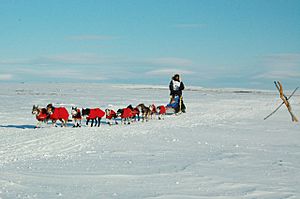
The finish line is the "burled arch" in Nome. The original arch was used from 1975 to 2001. The new arch is a spruce log. It says "End of Iditarod Sled Dog Race."
A "Widow's Lamp" is lit and hangs on the arch. It stays lit until the last musher finishes. This tradition comes from old roadhouses. They would light a lamp when a musher was on the way. The last musher to finish the Iditarod is called the "Red Lantern".
As mushers near the arch, the city's fire siren sounds. This happens when they are 2 miles from the finish. The first winner in 1973 took over 20 days. Now, winners finish in under 10 days. This is because the trail is better prepared. Also, dog training has improved.
An awards banquet is held the Sunday after the winner arrives. Everyone who finishes the race gets a special belt buckle and patch.
Who Participates?
More than 50 mushers enter each year. Most are from Alaska. A few are from other US states, Canada, or other countries. Some mushers are professionals. They earn money from selling dogs, giving tours, or speaking about the Iditarod. Others are amateurs. They might hunt, fish, or have seasonal jobs. Lawyers, doctors, and pilots have also competed.
Mushers must complete three smaller races to qualify for the Iditarod. They can lease dogs for the race. Rookie mushers must finish other races first.
The cost to enter the race and care for dogs can be high. It can range from $10,000 to $40,000. Top teams might spend $80,000 to $100,000 per year. This includes special lightweight gear, high-energy dog food, and vet care. The winner receives a new pickup truck and prize money. In 2015, the winner got $69,000. Other top finishers also receive cash prizes.
The Amazing Dogs

An Alaskan Malamute, a strong sled dog breed.
|

A Siberian Husky, known for speed.
|
The first sled dogs were bred by Native American Mahlemuit people. They were later mixed with other breeds like Alaskan huskies and Siberian Huskies. Siberian Huskies became very popular for racing in the early 1900s.
Today's racing dogs are mixed-breed huskies. They are bred for speed, tough feet, and endurance. They also need a good attitude and a strong desire to run. Dogs for long races weigh about 45 to 55 pounds (20–25 kg).
Since 1984, all dogs are checked by vets before the race. They look for injuries or pregnancy. All dogs have microchips and collar tags. Along the trail, volunteer vets check each dog. They look at their heart, hydration, and overall health. Mushers cannot give drugs that hide injuries.
Each team has 12 to 14 dogs. No more can be added during the race. At least five dogs must be pulling the sled at the finish line. Mushers keep a vet diary. Vets sign it at each checkpoint. Dogs that are tired or hurt can ride in the sled. They are then flown to a special dog-drop site. From there, they go to a care center or home. Dogs might be dropped for many reasons. These include being tired, sick, or not fast enough.
Iditarod dogs are amazing athletes. They start training in late summer or fall. Competitive teams run 2,000 miles (3,200 km) before the race. When there's no snow, they train with wheeled carts. An Iditarod dog burns about 9,666 calories each day. This is twice as much as a human Tour de France cyclist! Their bodies are built for extreme endurance.
Race Records and Awards
Dick Wilmarth won the first race in 1973. His time was 20 days, 0 hours, 49 minutes, and 41 seconds. The fastest time was set by Mitch Seavey in 2017. He finished in 8 days, 3 hours, 40 minutes, and 13 seconds. The closest finish was in 1978. Dick Mackey won by just one second over Rick Swenson.
Rick Swenson was the first musher to win four races (in 1982). In 1991, he won his fifth race. He is the only musher to win in three different decades. Susan Butcher, Doug Swingley, Martin Buser, Jeff King, Lance Mackey, and Dallas Seavey have also won four or more times. In 2021, Dallas Seavey won his fifth race.
Mary Shields was the first woman to finish the race in 1974. In 1985, Libby Riddles became the first woman to win. She was brave enough to race through a blizzard. She became famous and was named Professional Sportswoman of the Year. Susan Butcher won the next year. She went on to win three more times.
Doug Swingley from Montana was the first non-Alaskan to win (in 1995). Mushers from 14 countries have competed. In 1992, Martin Buser from Switzerland was the first non-American to win. In 2003, Robert Sørlie from Norway was the first non-US resident to win.
In 2007, Lance Mackey became the first musher to win both the Yukon Quest and the Iditarod in the same year. He did it again in 2008. Lance, his father Dick, and his brother Rick have all won the Iditarod.
The "Golden Harness" is given to the lead dog(s) of the winning team. Mushers vote for this award. The "Rookie of the Year" award goes to the best-finishing first-time musher. The "Red Lantern" is given to the last musher to cross the finish line. This award celebrates their perseverance.
Iditarod Winners
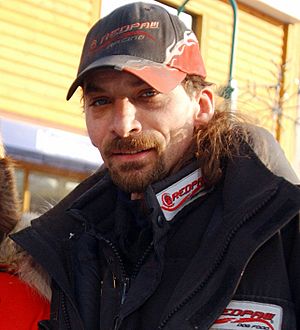
| Year | Musher (wins) | Lead dog(s) | Time (h:min:s) |
|---|---|---|---|
| 1973 | Hotfoot | 20 days, 00:49:41 | |
| 1974 | Nugget | 20 days, 15:02:07 | |
| 1975 | Nugget and Digger | 14 days, 14:43:45 | |
| 1976 | Puppy and Sugar | 18 days, 22:58:17 | |
| 1977 | Andy and Old Buddy | 16 days, 16:27:13 | |
| 1978 | Skipper and Shrew | 14 days, 18:52:24 | |
| 1979 | Andy and Old Buddy | 15 days, 10:37:47 | |
| 1980 | Wilbur and Cora Gray | 14 days, 07:11:51 | |
| 1981 | Andy and Slick | 12 days, 08:45:02 | |
| 1982 | Andy and Rex Burkhead | 16 days, 04:40:10 | |
| 1983 | Preacher and Jody | 12 days, 14:10:44 | |
| 1984 | Red and Bullet | 12 days, 15:07:33 | |
| 1985 | Axle and Dugan | 18 days, 00:20:17 | |
| 1986 | Granite and Mattie | 11 days, 15:06:00 | |
| 1987 | Granite and Mattie | 11 days, 02:05:13 | |
| 1988 | Granite and Tolstoi | 11 days, 11:41:40 | |
| 1989 | Rambo and Ferlin the Husky | 11 days, 05:24:34 | |
| 1990 | Sluggo and Lightning | 11 days, 01:53:23 | |
| 1991 | Goose | 12 days, 16:34:39 | |
| 1992 | Tyrone and D2 | 10 days, 19:17:15 | |
| 1993 | Herbie and Kitty | 10 days, 15:38:15 | |
| 1994 | D2 and Dave | 10 days, 13:05:39 | |
| 1995 | Vic and Elmer | 10 days, 13:02:39 | |
| 1996 | Jake and Booster | 9 days, 05:43:13 | |
| 1997 | Blondie and Fearless | 9 days, 08:30:45 | |
| 1998 | Red and Jenna | 9 days, 05:52:26 | |
| 1999 | Stormy, Cola and Elmer | 9 days, 14:31:07 | |
| 2000 | Stormy and Cola | 9 days, 00:58:06 | |
| 2001 | Stormy and Peppy | 9 days, 19:55:50 | |
| 2002 | Bronson | 8 days, 22:46:02 | |
| 2003 | Tipp | 9 days, 15:47:36 | |
| 2005 | Sox and Blue | 9 days, 18:39:30 | |
| 2006 | Salem and Bronte | 9 days, 11:11:36 | |
| 2007 | Larry and Lippy | 9 days, 05:08:41 | |
| 2008 | Larry and Hobo | 9 days, 11:46:48 | |
| 2009 | Larry and Maple | 9 days, 21:38:46 | |
| 2010 | Maple | 8 days, 23:59:09 | |
| 2011 | Velvet and Snickers | 8 days, 18:46:39 | |
| 2012 | Guinness and Diesel | 9 days, 04:29:26 | |
| 2013 | Tanner and Taurus | 9 days, 07:39:56 | |
| 2014 | Beetle and Reef | 8 days, 13:04:19 | |
| 2015 | Reef and Hero | 8 days, 18:13:06 | |
| 2016 | Reef and Tide | 8 days, 11:20:16 | |
| 2017 | Pilot and Crisp | 8 days, 03:40:13 | |
| 2018 | Russeren and Olive | 9 days, 12:00:00 | |
| 2019 | Marrow and Lucy | 9 days, 12:39:06 | |
| 2020 | K2 and Bark | 9 days, 10:37:47 | |
| 2021 | North and Gamble | 7 days, 14:08:57 | |
| 2022 | Morello and Slater | 8 days, 14:38:43 | |
| 2023 | Ghost and Sven | 8 days, 21:13:58 |
Mushers with Multiple Wins
| Winner | Races Won | Years Won |
|---|---|---|
| Dallas Seavey | 5 | 2012, 2014, 2015, 2016, 2021 |
| Rick Swenson | 5 | 1977, 1979, 1981, 1982, 1991 |
| Lance Mackey | 4 | 2007, 2008, 2009, 2010 |
| Jeff King | 4 | 1993, 1996, 1998, 2006 |
| Martin Buser | 4 | 1992, 1994, 1997, 2002 |
| Doug Swingley | 4 | 1995, 1999, 2000, 2001 |
| Susan Butcher | 4 | 1986, 1987, 1988, 1990 |
| Mitch Seavey | 3 | 2004, 2013, 2017 |
| Robert Sørlie | 2 | 2003, 2005 |
Winners by Birth Country
| Country | Wins | Winners |
|---|---|---|
| 43 | 21 | |
| 4 | 3 | |
| 4 | 1 |
American Winners by Birth State
| State | Wins | Winners |
|---|---|---|
| 10 | 7 | |
| 9 | 3 | |
| 5 | 1 | |
| 4 | 1 | |
| 4 | 1 | |
| 4 | 1 | |
| 2 | 2 | |
| 2 | 2 | |
| 1 | 1 | |
| 1 | 1 | |
| 1 | 1 |
Images for kids
-
Statue of Balto in Central Park, New York City
-
The old "Burled Arch" finish line in Nome, Alaska, pictured in 1977. It was replaced in 2001.
See Also
 In Spanish: Iditarod para niños
In Spanish: Iditarod para niños
- American Dog Derby (Idaho, USA)
- Arctic Alps Cup (La Grande Odyssée & Finnmarksløpet)
- Finnmarksløpet (Norway)
- La Grande Odyssée (France and Switzerland)
- List of sled dog races
- Yukon Quest (From Alaska to Yukon)




